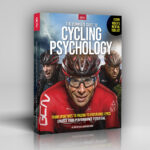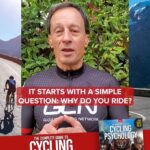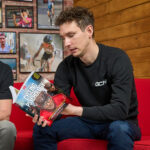As I discussed in my first post, Prime Cycling is defined as “riding at a consistently high level under the most challenging training and race conditions.” Prime Cycling is a goal toward which everyone in the cycling world should strive, the result of which is to maximize your riding efforts and enable you to achieve your cycling goals. But, as someone who has worked with both professional riders individually and several pro teams, it has been my experience that few cyclists, coaches, or teams understand fully the information and strategies they must use to achieve their goals. Nor do many have a framework or a process for working toward Prime Cycling. And even fewer have implemented such important changes.
Prime Cycling Pyramid
The Prime Cycling Pyramid provides both a framework and a process for identifying and developing the key contributors to individual and team cycling performance. The Prime Cycling Pyramid is comprised of five psychological factors that most directly impact riding performance (see pyramid at right). These factors can either facilitate or interfere with performance. Your goal is to understand your relationship with each of these mental factors and develop strategies and a plan of action for alleviating your psychological weaknesses and building on the psychological strengths.
The Prime Cycling Pyramid is ordered in a purposeful and logical manner. Its order is based on the sequence in which the factors impact riding performance. The first two factors (motivation and confidence) prepare you for races, while the next three (intensity, focus, and emotions) directly impact your training and competitive performances.
Motivation. At the foundation of the Prime Cycling Pyramid lies motivation, because without the determination and drive to take action in pursuit of your goals, all efforts would stop and any other contributors to performance, whether physical, technical, equipment, or team, would be moot. Motivation ensures that you do everything you can to be totally prepared to achieve your goals. Essential to developing motivation is understanding what motivates you and how you can continue to work hard in the face of fatigue, pain, setbacks, frustration, and injuries. Certainly the best riders in the world, such as Ryder Hesjedal and Frank Schleck, are driven to endure incredible hardship in pursuit of their goals.
Confidence. There is no more important mental factor than confidence because you might have all ability in the world to achieve your goals, but if you don’t have confidence in that ability, you won’t use that ability. For example, you may be physically capable of hanging with the lead group up a three-mile climb, but if you don’t believe you have the fitness to make it to the top with them, you won’t maintain the pace necessary to stay in the front group. Many cyclists defeat themselves even before a race begins with doubts and negative self-talk. Like all mental skills, confidence is a skill that develops with practice. A deep faith in your capabilities comes from total preparation, exposure to adversity, support from others, and training and race success. There is no doubt, for example, that Mark Cavendish is one confident sprinter and that Cadel Evans knows with certainty that he’ll be in the mix at the end of the Tour de France.
Intensity. Intensity may be the most important contributor to cycling performance once the race begins. It’s so important because all of the motivation, confidence, focus, and emotions in the world won’t help you if your body is not physiologically capable of doing what it needs to do for you to ride your best. Intensity involves the amount of physiological activation you feel before and during training and races and lies on a continuum between sleep (very low intensity) to terror (very high intensity). Somewhere between those two extremes you perform your best and your challenge is to find the ideal level of intensity that works best for you in your riding. Sprinters have to have the ability to stay relaxed through most of a race, but then be able to kick it into high gear, literally and physiologically, in a short time as the finish approaches. By contrast, climbers need to stay relaxed during long climbs to conserve energy and keep the inevitable pain of a steep ascent in control.
Focus. Focus involves the ability to concentrate on those things that help you ride your best, shift focus when the demands of the situation change, and avoid distractions that are ever present in road racing. The ability to focus effectively is especially important in cycling where distractions are everywhere (including those goofy fans in the wild outfits) and changes can occur any second of a race, for example, a breakaway, a different road surface, or a crash just ahead.
Emotions. Cycling can evoke a wide range of emotions, from inspiration, pride, exhilaration, and satisfaction, to fear, frustration, anger, and despair. Emotions lie at the top of the Prime Cycling Pyramid because I have found that they are the ultimate determinant of your ability to ride at your best consistently under the most challenging conditions. If you ride on a team, emotions also contribute significantly to your abilities as a leader and a team member. Most powerfully, emotional mastery gives you the power to use emotions as tools to facilitate individual and team cycling performance rather than weapons that hurt you and your teammates. If you look back on the great riders of the past, you see how they used their emotions to propel them to the front of the peloton, whether Lance Armstrong’s icy glare or Mario Cipollini’s fiery finish.
Developing Prime Cycling
The Prime Cycling Pyramid gives you the framework from which to explore the psychological factors that most impact your cycling. It should now act as the foundation for the process of improvement that will allow you to maximize your training and race performances and achieve your goals.
The goal of my cycling posts is to add mental tools to your physical, technical, tactical, and equipment toolbox that you already have. My future posts will examine in depth these factors and offer you practical information and useful mental tools for the Prime Cycling Pyramid that you can use the next time you ride or race.
Prime Cycling isn’t Magic
It’s important to note that Prime Cycling isn’t magic dust and will not produce miracles. You would not expect increases in your cycling fitness by riding every few weeks or an improvement in descending by working on it once in a while. The only way to improve any area, whether physical, technical, or mental, is through commitment, hard work, and patience. If you make the same commitment to your mental training that you do to your physical training, Prime Cycling will play a key role in helping you achieve your riding goals.






